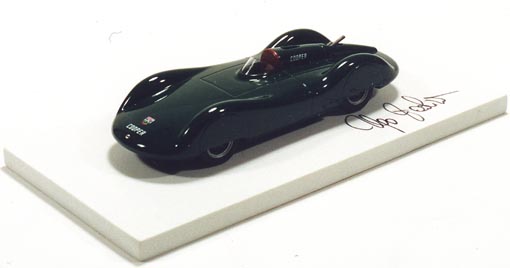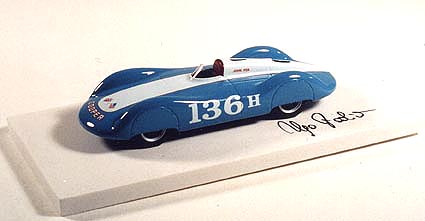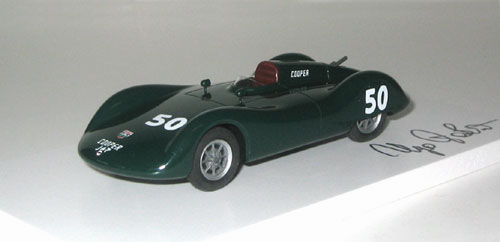
The Cooper T17 MarkV(R), streamlined record breaker
By 1951 the 500 cc Formula 3 was a huge success in England and Cooper was recognised as the leading manufacturer. It came as no surprise that Charles Cooper and his son John thought about building a special car to attack speed records, which at the time were still considered an important mean to confirm the quality and reliability of a race car.
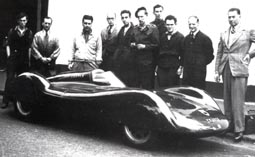
The car as introduced to the press (third from left is John Cooper)
(Photo from "Cooper Cars" by Doug Nye)
The car was based on the current Mark V Formula 3 chassis, in the slightly stretched version created to take a JAP 1.100 cc twin for hill climbs. The engine was of course at the back, with chain-drive transmission and a Norton gearbox; suspension was independent all round, with leaf springs and wishbones and rack and pinion steering. What made the difference was a completely new streamlined single seater body made of aluminum panels, which, although all-enveloping, offered a smaller frontal area than the standard track body. This was allowed by the much lower driving position, which was obtained by altering the steering layout, which now had an almost horizontal steering wheel.

Getting ready at Montlhéry, 1951
(Photo from Cooper Cars)
The body was developed through extensive wind tunnel testing, something fairly unusual for a small company like Cooper Cars was at the time and was considerably altered after these tests, when compared with the original design by Owen Maddock (of December 1950): in the end the car looked pretty much like a scaled down pre-war Auto Union streamliner.
JAP and Norton motorcycle engines of different sizes could be mounted (although only JAP were eventually used in this car when raced by Cooper), and the original plans were to attack records in the I (500 cc) and J (350 cc) classes with twin and single JAP engines respectively, and eventually also try for the Class H (750 cc) and G (1100 cc) records.

At full speed at Montlhéry in 1951
(Photo from IOTA magazine)
After just a 10-mile test drive on the Kenley Airfield, where it reached 140 MPH with a JAP 1.100 engine, the car was brought to the banked circuit of Montlhéry, just outside Paris, and on October 8 it easily set 6 records (from 50 Km to 200 Km) in Class J, with John Cooper at the wheel, and then the same six records in Class I (500cc) the next day, driven by Bill Aston, who was actually the owner of the car. Then he left the steering wheel to Cooper again, to go on for the 200 Miles record, but the fuel consumption had been miscalculated and the car stopped after just a few laps; but they were happy enough with what they had achieved and they called it a day. Most of the records were formerly held by rival Kieft, set the year before with a standard Formula 3 car. (Ugo Fadini model n.16A)

At Montlhéry, October 1952
(Photo from "L'Automobile")
At the end of the attempts Cooper announced that they would be back in the spring of 1952 for more attempts, possibly in the larger displacement classes. Again JAP engines would be used for all attempts, including supercharged versions of the 350 and 500 cc units to challenge the flying Km records.
The racing season then took all the time (and the streamliner too was used in a cirquit race, see below) and the team eventually returned to Montlhéry much later than planned, on October 12, but the attempts had to be cancelled because of... heavy snow!
The only visible changes were the low-cut windshield and the addition of a JAP label on the nose (both already seen at the Granzlandring).
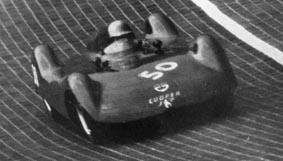
At the Avus in 1953
(Photo from "The Racing
Coopers" by ArthurOwen)
The car was also used a couple of times in circuit races in Germany (minus front wheel covers and plus rear view mirrors). Both times John Cooper was the driver and both times he won: at the Grenzlandring in August 1952 and at the Avus in June 1953, where the car was involved in a multiple accident at the beginning of the race, John Cooper had to push-restart it himself and still managed to win the race! (Ugo Fadini model n.16C)
By 1953 Cooper was building a new streamliner for Eric Brandon: of a similar design and appearance, but lighter and based on the newer Mark VIII chassis, it eventually set more records in three different classes, again at Montlhéry, in october 1953.
But the career of the original streamliner was not over.

The streamliner repainted for John Fox
The car was handed over to John Fox of San Anselmo, CA, who had just set up a Cooper dealership there, to be run at Bonneville both in the SCTA Speed Trials and also in the AAA International trials for official FIA records.
It is not clear wether the car was sold or loaned to Fox, but anyway the car was delivered to him by John Cooper in person at the Cooper factory, ready in its new livery of light blue and white, and the entrant for the august 1954 SCTA Speed Trials was "Cooper Racing Cars of England". (Ugo Fadini model n.16B)
It was entered in three different classes, H, O and A, which at the time meant respectively 0 to 48 cubic inches, 49 to 91 and 92 to 183.
Reports conflict a little bit about which engines were actually used and with which capacity, but apparently the car ran 107.91 in O Class using a JAP, then set a new class H record at 110.75 mph (with the fastest run at 112.21), using a 30.5 cu.in. engine, either a Norton or a JAP. Then the Harley engine from C.B. Clausen's "The Brute" motorcycle streamliner was installed and Bud Hood took the wheel as Fox, who was a newcomer to the Salt Flats, was not up to the task. But the Harley was too much for the weak Norton transmission, which broke almost immediately and the week was soon over.
The H class record was faster than the car had run at Montlhéry in 1951, but slower than the current FIA record for the same displacement. That may be the reason why the car did not compete, as originally planned, in the AAA trials that followed the SCTA week at Bonneville, in which other US streamliners took several FIA International records.
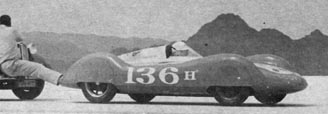
The Cooper at the 1954 Bonneville Speed Week
(Photo from Motor Life magazine)
In 1955 Fox and the Cooper were back and did even better, pushing the H Class record up to 118.271 mph, this time definitely using a Norton 40 (or 48?) cu.in. Interestingly, Fox also drove a standard Formula 3 Cooper in the lakester H class, where he also set a record at 91.102!
The 1956 program lists again the car as an O class entry with a Coventry-Climax engine, but I found no mention of it in the press reports, so either it did not race or anyway did not set any records. A "Cooper-Triumph" bettered Fox's H Class Lakester record by a fraction, but I could not find any mention of the driver, so I am not sure wether it was his car again or a different one.
As of today, the later history and fate of the car is unknown to me and I would be most grateful for any information any interested readers of this page could provide.
NOTE: In an earlier version of this page, I stated, based on an article on a UK magazine, that the car was later sold to Pete Lovely, who turned it into a sports racer fitting a Porsche engine. Thanks to an exchange of emails with readers and further checking other sources, I came to the conclusion that this statement was wrong, since Lovely's Pooper was racing as early as May 1955, three months before the last confirmed appearance of Fox's car at Bonneville. Lovely's Pooper was definitely based on the second factory (Brandon's) streamliner (see below).
I apologize to readers I may have mislead.
All the records set by the Cooper T17 MarkV(R)
"FIA" International records for Category A Group I, in the Class indicated.
"SCTA" records set during Bonneville National Speed Trials according to the SCTA rule book, ("S" stands for streamliner class).


